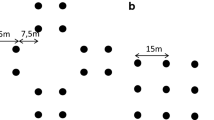Abstract.
Socioecological theory predicts that the distribution of fertile females in space and time is the major determinant of male spacing behavior and mating strategies. Using a small nocturnal Malagasy primate, the gray mouse lemur (Microcebus murinus), we determined the spatiotemporal distribution of estrous females during the brief annual mating season to examine the predictive power of the socioecological model for male mating strategies. Mouse lemurs are particularly interesting in this respect because this polygynous species is characterized by seasonal reproduction, seasonally reversed sexual dimorphism, and relatively large testes. All resident animals in our 8-ha study area, a total of 30 adult males and 27 adult females, were individually marked and regularly recaptured to determine female reproductive status and to obtain home range data. We found that the mating season is limited to 4 weeks following female emergence from hibernation. Only 3–9 females could have synchronized estruses during a given week, indicating a moderately high male monopolization potential. However, receptive females were not spatially clumped and male ranges overlapped with those of many other rivals. Therefore, we suggest that individual powerful males may be unable to defend exclusive permanent access to receptive females because of prohibitive costs of range defense resulting from the strongly male-biased operational sex ratio and the corresponding intruder pressure. Our general conclusions are (1) that the socioecological model provides a useful heuristic framework for the study of mating systems, but that (2) it does not specify the degree of spatiotemporal clumping of receptive females at which male mating strategies switch among mate guarding, spatial exclusion of rivals, and roaming, and that (3) the operational sex ratio can have profound effects on male mating strategies as well.
Similar content being viewed by others
Author information
Authors and Affiliations
Additional information
Electronic Publication
Rights and permissions
About this article
Cite this article
Eberle, M., Kappeler, P.M. Mouse lemurs in space and time: a test of the socioecological model. Behav Ecol Sociobiol 51, 131–139 (2002). https://doi.org/10.1007/s002650100409
Received:
Revised:
Accepted:
Issue Date:
DOI: https://doi.org/10.1007/s002650100409




